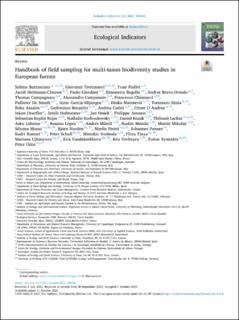Handbook of field sampling for multi-taxon biodiversity studies in European forests
| dc.contributor.author | Burrascano, Sabina | |
| dc.contributor.author | Trentanovi, Giovanni | |
| dc.contributor.author | Paillet, Yoan | |
| dc.contributor.author | Heilmann-Clausen, Jacob | |
| dc.contributor.author | Giordani, Paolo | |
| dc.contributor.author | Bagella, Simonetta | |
| dc.contributor.author | Bravo-Oviedo, Andrés | |
| dc.contributor.author | Campagnaro, Thomas | |
| dc.contributor.author | Campanaro, Alessandro | |
| dc.contributor.author | Francesco, Chianucci | |
| dc.contributor.author | De Smedt, Pallieter | |
| dc.contributor.author | Itziar, García-Mijangos | |
| dc.contributor.author | Matošević, Dinka | |
| dc.contributor.author | Sitzia, Tommaso | |
| dc.contributor.author | Aszalós, Réka | |
| dc.contributor.author | Brazaitis, Gediminas | |
| dc.contributor.author | Andrea, Cutini | |
| dc.contributor.author | Ettore, D'Andrea | |
| dc.contributor.author | Doerfler, Inken | |
| dc.contributor.author | Hofmeisterr, Jeňýk | |
| dc.contributor.author | Hošeks, Jan | |
| dc.contributor.author | Janssen, Philippe | |
| dc.contributor.author | Rojas, Sebastian Kepfer | |
| dc.contributor.author | Korboulewsky, Nathalie | |
| dc.contributor.author | Kozák, Daniel | |
| dc.contributor.author | Lachat, Thibault | |
| dc.contributor.author | Lõhmus, Asko | |
| dc.contributor.author | Lopez, Rosana | |
| dc.contributor.author | Mårell, Anders | |
| dc.contributor.author | Matula, Radim | |
| dc.contributor.author | Mikoláš, Martin | |
| dc.contributor.author | Munzi, Silvana | |
| dc.contributor.author | Nordén, Björn | |
| dc.contributor.author | Pärtel, Meelis | |
| dc.contributor.author | Penner, Johannes | |
| dc.contributor.author | Runnel, Kadri | |
| dc.contributor.author | Schall, Peter | |
| dc.contributor.author | Svoboda, Miroslav | |
| dc.contributor.author | Tinya, Flóra | |
| dc.contributor.author | Ujházyová, Mariana | |
| dc.contributor.author | Vandekerkhove, Kris | |
| dc.contributor.author | Verheyen, Kris | |
| dc.contributor.author | Xystrakis, Fotios | |
| dc.contributor.author | Ódor, Péter | |
| dc.date.accessioned | 2022-03-25T09:31:53Z | |
| dc.date.available | 2022-03-25T09:31:53Z | |
| dc.date.created | 2021-10-13T07:35:19Z | |
| dc.date.issued | 2021 | |
| dc.identifier.issn | 1470-160X | |
| dc.identifier.uri | https://hdl.handle.net/11250/2987574 | |
| dc.description.abstract | Forests host most terrestrial biodiversity and their sustainable management is crucial to halt biodiversity loss. Although scientific evidence indicates that sustainable forest management (SFM) should be assessed by monitoring multi-taxon biodiversity, most current SFM criteria and indicators account only for trees or consider indirect biodiversity proxies. Several projects performed multi-taxon sampling to investigate the effects of forest management on biodiversity, but the large variability of their sampling approaches hampers the identification of general trends, and limits broad-scale inference for designing SFM. Here we address the need of common sampling protocols for forest structure and multi-taxon biodiversity to be used at broad spatial scales. We established a network of researchers involved in 41 projects on forest multi-taxon biodiversity across 13 European countries. The network data structure comprised the assessment of at least three taxa, and the measurement of forest stand structure in the same plots or stands. We mapped the sampling approaches to multi-taxon biodiversity, standing trees and deadwood, and used this overview to provide operational answers to two simple, yet crucial, questions: what to sample? How to sample? The most commonly sampled taxonomic groups are vascular plants (83% of datasets), beetles (80%), lichens (66%), birds (66%), fungi (61%), bryophytes (49%). They cover different forest structures and habitats, with a limited focus on soil, litter and forest canopy. Notwithstanding the common goal of assessing forest management effects on biodiversity, sampling approaches differed widely within and among taxonomic groups. Differences derive from sampling units (plots size, use of stand vs. plot scale), and from the focus on different substrates or functional groups of organisms. Sampling methods for standing trees and lying deadwood were relatively homogeneous and focused on volume calculations, but with a great variability in sampling units and diameter thresholds. We developed a handbook of sampling methods (SI 3) aimed at the greatest possible comparability across taxonomic groups and studies as a basis for European-wide biodiversity monitoring programs, robust understanding of biodiversity response to forest structure and management, and the identification of direct indicators of SFM. Biodiversity Field methods Multi-taxon Indicators Sampling protocol Forest stand structure | en_US |
| dc.language.iso | eng | en_US |
| dc.rights | Navngivelse 4.0 Internasjonal | * |
| dc.rights.uri | http://creativecommons.org/licenses/by/4.0/deed.no | * |
| dc.subject | Biodiversity | en_US |
| dc.subject | Field methods | en_US |
| dc.subject | Multi-taxon | en_US |
| dc.subject | Indicators | en_US |
| dc.subject | Sampling protocol | en_US |
| dc.subject | Forest stand structure | en_US |
| dc.title | Handbook of field sampling for multi-taxon biodiversity studies in European forests | en_US |
| dc.type | Peer reviewed | en_US |
| dc.type | Journal article | en_US |
| dc.description.version | publishedVersion | en_US |
| dc.rights.holder | © 2021 The Authors | en_US |
| dc.subject.nsi | VDP::Zoologiske og botaniske fag: 480 | en_US |
| dc.subject.nsi | VDP::Zoology and botany: 480 | en_US |
| dc.subject.nsi | VDP::Zoologiske og botaniske fag: 480 | en_US |
| dc.subject.nsi | VDP::Zoology and botany: 480 | en_US |
| dc.source.volume | 132 | en_US |
| dc.source.journal | Ecological Indicators | en_US |
| dc.identifier.doi | 10.1016/j.ecolind.2021.108266 | |
| dc.identifier.cristin | 1945478 | |
| dc.relation.project | EC/H2020/COST Action CA18207 | en_US |
| dc.source.articlenumber | 108266 | en_US |
| cristin.ispublished | true | |
| cristin.fulltext | original | |
| cristin.qualitycode | 1 |
Tilhørende fil(er)
Denne innførselen finnes i følgende samling(er)
-
Publikasjoner fra CRIStin - NINA [2364]
-
Scientific publications [1392]
Vitenskapelige artikler, kapitler og monografier i Open Access.

